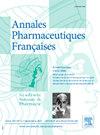含有牛至、洋甘菊和薰衣草的智能黏附鼻凝胶对ptz诱导大鼠癫痫发作的控制及评价。
IF 1.1
Q4 PHARMACOLOGY & PHARMACY
引用次数: 0
摘要
背景:癫痫是一种常见的以反复发作为特征的神经系统疾病,影响全球约1%的人口。尽管抗癫痫药物的可用性,很大比例的患者经历不受控制的癫痫发作,这需要发展替代治疗策略。草药因其潜在的抗惊厥特性而受到关注。目的:研究牛至、洋甘菊和薰衣草水醇提取物对戊四唑(PTZ)致大鼠癫痫模型的抗惊厥作用。此外,它试图制定和评估含有这些提取物的黏附鼻水凝胶。方法:采用乙醇(70%)浸渍制备中药提取物,参照伊朗药典标准进行分析。采用分光光度法测定总酚含量(TPC)。使用不同的凝胶剂,优化鼻腔水凝胶配方的黏附性和凝胶性。采用戊四唑(PTZ)致痫模型,在体内评价其抗惊厥活性。结果:中药提取物符合药典标准,鼻用水凝胶制剂具有良好的理化性质,包括最佳pH值和黏附强度。体内研究表明,与阴性对照组相比,鼻内给药34 mg/kg的草药提取物可显著延迟癫痫发作,降低癫痫发作强度。结论:含有牛至、洋甘菊和薰衣草提取物的智能黏附鼻水凝胶具有良好的抗惊厥活性,表明其有潜力成为一种新型的、无创的癫痫治疗替代方案。本文章由计算机程序翻译,如有差异,请以英文原文为准。
Formulation and evaluation of a smart mucoadhesive nasal gel containing oregano, chamomile, and lavender for seizure control in PTZ-induced seizure model in rats
Background
Epilepsy is a prevalent neurological disorder characterized by recurrent seizures, affecting approximately 1% of the global population. Despite the availability of antiepileptic drugs, a significant proportion of patients experience uncontrolled seizures, which necessitates the development of alternative therapeutic strategies. Herbal medicine has gained attention due to its potential anticonvulsant properties.
Objectives
This study aimed to assess the anticonvulsant effects of hydroalcoholic extracts of oregano, chamomile, and lavender in rats’ pentylenetetrazol (PTZ)- induced seizure model. Furthermore, it sought to formulate and evaluate a mucoadhesive nasal hydrogel containing these extracts.
Methods
The herbal extracts were prepared using ethanol (70%) through maceration and analyzed based on the Iranian Herbal Pharmacopeia standards. Total phenolic content (TPC) was quantified using the spectrophotometric method to standardize the extracts. Using various gelling agents, the nasal hydrogel formulation was optimized for mucoadhesion and gelation properties. The anticonvulsant activity was evaluated in vivo using seizure models induced by pentylenetetrazol (PTZ).
Results
The herbal extracts met the pharmacopeial standards, and the nasal hydrogel formulation demonstrated favorable physicochemical properties, including optimal pH and mucoadhesive strength. In vivo studies showed that intranasal administration of the herbal extracts significantly delayed seizure onset and reduced seizure intensity at a dose of 34 mg/kg, compared to the negative control group (P < 0.001).
Conclusion
The smart mucoadhesive nasal hydrogel containing oregano, chamomile, and lavender extracts exhibited promising anticonvulsant activity, suggesting its potential as a novel, non-invasive alternative for epilepsy management.
Contexte
L’épilepsie est un trouble neurologique répandu caractérisé par des crises récurrentes, touchant environ 1 % de la population mondiale. Malgré la disponibilité des médicaments antiépileptiques, une proportion importante de patients souffrent de crises incontrôlées, ce qui nécessite le développement de stratégies thérapeutiques alternatives. La phytothérapie a attiré l’attention en raison de ses propriétés anticonvulsivantes potentielles.
Objectifs
Cette étude visait à évaluer les effets anticonvulsivants des extraits hydroalcooliques d’origan, de camomille et de lavande dans le modèle de crise induite par le pentylènetétrazole (PTZ) chez le rat. De plus, elle visait à formuler et à évaluer un hydrogel nasal mucoadhésif contenant ces extraits.
Méthodes
Les extraits de plantes ont été préparés à l’éthanol (70 %) par macération et analysés selon les normes de la pharmacopée iranienne à base de plantes. La teneur phénolique totale (TPC) a été quantifiée à l’aide de la méthode spectrophotométrique pour normaliser les extraits. La formulation d’hydrogel nasal a été optimisée pour les propriétés de mucoadhésion et de gélification à l’aide de divers agents gélifiants. L’activité anticonvulsivante in vivo a été évaluée dans des modèles de crises induites par PTZ.
Résultats
Les extraits de plantes répondaient aux normes de la pharmacopée et la formulation d’hydrogel nasal a démontré des propriétés physicochimiques favorables, notamment un pH optimal et une force mucoadhésive. Des études in vivo ont montré que l’administration intranasale des extraits de plantes sous forme d’hydrogel intranasal mucoadhésif gélifiant in situ retardait significativement l’apparition des crises et réduisait leur intensité à une dose de 34 mg/kg, par rapport au groupe témoin négatif (p < 0,001).
Conclusion
L’hydrogel nasal mucoadhésif intelligent contenant des extraits d’origan, de camomille et de lavande a montré une activité anticonvulsivante prometteuse, suggérant son potentiel en tant qu’alternative nouvelle et non invasive pour la gestion de l’épilepsie.
求助全文
通过发布文献求助,成功后即可免费获取论文全文。
去求助
来源期刊

Annales pharmaceutiques francaises
PHARMACOLOGY & PHARMACY-
CiteScore
1.70
自引率
7.70%
发文量
98
期刊介绍:
This journal proposes a scientific information validated and indexed to be informed about the last research works in all the domains interesting the pharmacy. The original works, general reviews, the focusing, the brief notes, subjected by the best academics and the professionals, propose a synthetic approach of the last progress accomplished in the concerned sectors. The thematic Sessions and the – life of the Academy – resume the communications which, presented in front of the national Academy of pharmacy, are in the heart of the current events.
 求助内容:
求助内容: 应助结果提醒方式:
应助结果提醒方式:


